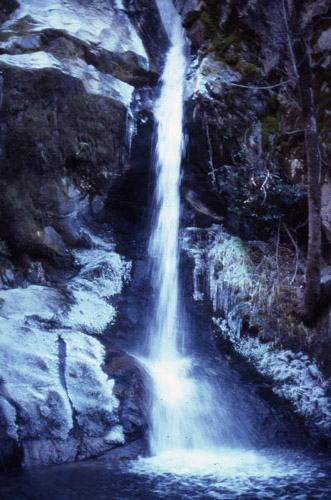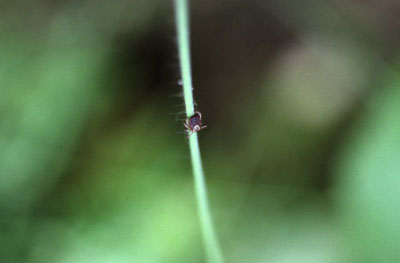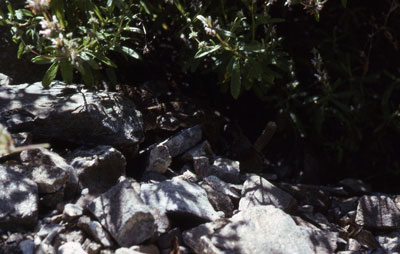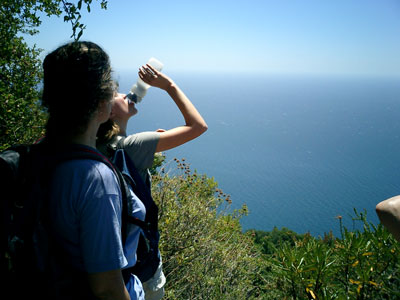“… if ye would go to the wilderness in search of your Mother, be careful and circumspect, lest she lure you into her secret places, whence ye may not come back.” – Jaime de Angulo

First of all, let us just state for the record that travel in the Santa Lucia mountains is dangerous and that, regardless of what you may read elsewhere on these pages, you should not under any circumstances go there. That being said, we will concede (albeit grudgingly) that a weekend spent in the Ventana Wilderness is still generally safer than a weekend spent at home and that the most dangerous part of nearly any trip to the Santa Lucias is the ride to the trailhead.
Even so, you probably ought to know about:
Dangerous Weather

Anyone for a bracing December dip in the pool below Pine Valley Falls? Just be careful not to slip on the ice in your haste to get out!
Santa Lucia locals tend to divide the year into two basic “seasons.” The Rainy Season and the Face Fly Season. The Rainy Season generally commences in October or November and usually lasts into May. During this time storms may arrive at any time. More often than not they come completely without warning. At the higher elevations the precipitation may fall as snow or, even more commonly, as a particularly irritating and uncomfortable mix of snow and rain. Sometimes the high ridges are simply pounded with fist-sized balls of slush.
And it doesn’t just rain a little. Rainfall totals in the Santa Lucias are much higher than on the coast and wind gusts routinely reach hurricane strength. You’d do well to remember that before setting up camp on an exposed ridge. But let’s not get carried away, here. While being cold and wet is sometimes a prelude to death by hypothermia, 99 times out of 100, it’s just being cold and wet.
People who go to the Ventana Wilderness Alliance Bulletin Board seeking advice are frequently given the impression by the local cognescenti that winter trips in the Ventana Wilderness are little more than invitations to death by hypothermia. While we appreciate the concern for safety, we think you ought to know that the typical story goes more like this:
“It was a beautiful sunny day. Not a wisp of cloud anywhere. The forecast called for sunny skies for the rest of the week. We didn’t see any point in setting up our tents. We lay out in our sleeping bags watching falling stars until we fell asleep. About two in the morning the rain woke us up. Big, ice cold drops. Within seconds it was a freezing downpour. We were stumbling around in the pitch dark trying to find our tents and set them up. Our sleeping bags, our packs, all our clothes, everything, was soaked before we even got our tents out of their bags. It was the worst night of our lives. The intense rain never eased up at all. As soon as it was light enough to see, we slogged back to the car through the still driving rain. When we got back to town we found out it had only sprinkled there.”
So if you manage to get wet and cold, don’t panic. Huddle together with your friends. Wrap yourself up in whatever you’ve got and remember that as long as you can find the trail, you can always just get up and walk out.
The face fly season needs no explanation to anyone who has experienced it and no explanation is possible to those who have not.
Dangerous Plants

The field of flowers looks tempting, but the yucca spines will slice through your clothes like a hot knife through butter
Without a doubt there is a lot of poison oak in the Santa Lucias. It twines as a vine through brush and trees. It stands on it’s own as an attractive bush along the sides of trails. It even, occasionally, takes on treelike proportions. If you are allergic to it, you must learn to recognize it in all its guises and remain constantly vigilant. Every part of it; leaves, berries stalks, twigs and roots carries the irritating oil.
There are those who claim to have gotten severe cases of poison oak by soaking in the springs at Sykes, but we suspect they got the oil on them on the way to the springs and that the warm water simply opened their pores and gave the oil a better chance to do its thing.
Poison oak, remember, causes an allergic reaction. This means that while the rash typically appears at the site of exposure, it doesn’t have to. It can appear anywhere on your skin that it pleases and, in severe cases, it pops up nearly everywhere. Also please remember that the serum that oozes from a severe poison oak rash is not poison oak oil and cannot “spread” the rash to other parts of your body or to other people. By the time the rash appears, the oil that caused it is almost certainly long gone from the surface of your skin (although not necessarily from your clothes – which, until washed, can go on giving poison oak rashes to you and your family for months and probably years).
Allergy experts insist that poison oak, as an allergen, should cause more and more severe reactions with repeated exposures, but this has not been our observation at all. We know of many people who, when they first arrived in poison oak country, immediately developed rashes severe enough to require medical intervention, yet with the passage of time and repeated exposure, eventually became nearly or completely immune.
The best defenses against poison oak, short of immunity, are:
1) Not getting it on you in the first place and;
2) Washing it off as quickly as possible (soap is helpful, as it’s an oil you’re trying to wash off, and cold water is probably preferable, since it’s less likely to open your pores).
There are a number of commercial products available to help in washing it off and/or treating the resulting rash and many people swear by them, but as we’re all more or less immune here at Xasáuan Today, we don’t know enough about them to recommend any. We do have friends, though, that swear the best relief from poison oak rash comes from soaking in the ocean. We can’t say how well it works, but it sounds like a great excuse for staying home from work and going surfing.
Assuming you don’t go around eating plants and berries at random (there are a variety of poisonous plants in the Santa Lucias) and you stay away from plants with spines and thorns (you’ll be amazed how sharp the yucca spines are – they’ll stab through those heavy duty expedition grade pants of yours so easily you’ll swear you must be naked), the only other plant likely to cause you much grief is stinging nettle. Hang around muddy areas at the edge of streams very much and you’ll soon find out which plant this is. Don’t worry, though, the stinging goes away after a while.
Dangerous Insects

A tick waits on a trailside blade of grass to hitch a ride on an unlucky traveler
The various flies, even those that bite and raise huge stinging welts, aren’t really dangerous (except, perhaps, to your mental health). If it’s fly season and you’re worried about them, bring a tent to escape into and a headnet.
The most common really dangerous insect is clearly the lowly tick. We are told there are upwards of forty species of ticks to be found around here and we’re pretty sure that at one time or another we’ve been bitten by every one of them – and we’ve gotten some really impressive infections from them too!
No one used to pay the ticks much mind. We just swore and yanked them out. Then along came the Lyme disease scare. We’re told that, in the Santa Lucias, Lyme disease is carried by just the female of just one tick species. The carrier tick is described as little and black – but that description works for quite a few other ticks as well. We’re also told that the tick generally has to stay attached to you for quite a few hours to give you the disease.
The bottom line is that you can all but eliminate the, already small, risk of contracting Lyme disease simply by paying attention to what’s walking around on you and your friends. And whether or not you’re worried about Lyme disease, this is definitely a worthwhile practice. In seeking to find out more about Lyme disease, we’ve learned that there are numerous distasteful diseases carried by ticks (diseases no less serious than Lyme disease, but lacking the professional PR help that the Lyme disease spirochete has received). And, as mentioned above, raging infections at the site of tick bites are quite common.
We now make a habit of looking down at our legs at regular intervals when we hike. When we feel things crawling around under our clothes, we take a look sooner rather than later. In bad tick country we give ourselves (with the help of friends, if available) regular and thorough tick inspections. As a result of adopting these practices we have gone from being bitten on a weekly basis to being bitten only a few times a year. People who spend less time out there could easily go years without a bite – if they just take their eyes off the scenery once in a while and give themselves a good scan.
A lot has been written in various guides about the places where ticks supposedly congregate. On south facing slopes, in certain kinds of brush, at certain times of year, and so on. We’re here to tell you that tick “blooms” can occur just about anywhere and at any time of year. We have walked along a trail in midsummer and seen no ticks at all, then come back a week later with the weather just as hot and sunny as before and had them swarm all over us. There are also places, like the bottom end of Blue Rock Ridge, which seem to have far more than their fair share of ticks year in and year out. When you hit a hot spot, don’t panic. Just stop every twenty or thirty feet and brush them off your legs. Within a mile or two they should thin out again.
Another insect worth considering, is the yellow jacket. All but absent during the coldest months, they can become serious pests by early fall. Their aggressiveness in seeking to drive you from your food is intensely annoying. Their stings, while painful, are not particularly dangerous – unless you get stung by a whole bunch of them at once. This happens to people who put their foot into a yellow jacket nest (most yellow jacket colonies in the Santa Lucias set up housekeeping in old gopher holes). The best way to avoid this fate is to watch where you’re going and avoid standing near holes in the ground that have yellow jackets streaming in and out of them. If you do manage to “put your foot in it,” just start running as fast as you can and keep it up until you’re sure they’re not after you any more. We’ve gotten off Scot free several times using this technique.
And speaking of being swarmed … there is also a species of ant in the Santa Lucias that, if you stand on its nest, will swarm in immense numbers over your entire body within only a few seconds. It’s absolutely amazing how fast these little buggers are and the speed with which their victims manage to undress has to be seen to be believed. Fortunately, their bites are not at all serious.
But it isn’t thoughts of ticks, wasps and ants that give us the creeps as we drift off to sleep at night. That honor is reserved for the illusive Kissing Bug. We’re not even going to talk about that.
Dangerous Reptiles

A well concealed rattlesnake lurks at the edge of the Pine Ridge Trail
Until fear of mountain lions came into vogue, the most feared animal in the Santa Lucias was undoubtedly the rattlesnake. While the hills certainly aren’t thick with them, they are definitely around and anyone who spends much time out there will sooner or later see one. Rattlesnake bites, however, are exceedingly rare. While painful, a rattlesnake bite is unlikely to be life threatening to anyone fit enough to be out there in the first place.
All this being said, the oft repeated maxim that rattlesnakes are more afraid of you than you are of them and that they will do everything they can to get away from you is, in a word, false. Most of the rattlesnakes we’ve encountered have either ignored us entirely or have coiled up in the middle of the trail and threatened to strike us. A few have even advanced on us – although slowly enough that getting away was not a problem. We have frequently backed way off, giving snakes every opportunity to make a graceful exit, only to have them plant themselves all the more firmly in the center of the trail. Many times we have tired of waiting and resorted to forcing them off the trail with a stick or a hail of small rocks and, let us assure you, they generally go fighting all the way.
In spite of their often militant attitude, rattlesnakes are better respected than feared. The way to avoid being bitten by them is to watch where you put your feet. It is also worth noting that where there is one rattlesnake there are frequently others, so be especially careful once you’ve seen one.
Dangerous Mammals

They may not look threatening, but people are still the most dangerous animals in the Santa Lucias
Although the rattlesnakes once reigned supreme in the terror department, they have been overshadowed in recent years by the mountain lions. The Santa Lucia mountains are in fact prime lion habitat and, some experts believe, they have the healthiest lion population in the lower 48 states. Fear of mountain lions is, in some ways, understandable. They clearly possess the ability to kill you. That does mean that every time you go into lion territory you are leaving it up to the cats to decide whether you will go on living. That fact alone is all some people seem to need in order to live in hatred and fear of them. The good news is that your chances of winning the lottery are considerably better than the chances that a lion will decide to kill you.
Just how rare are mountain lion attacks? Well more people are killed by domestic dogs every year than have been killed by mountain lions in all of recorded history. More people, in fact, are killed by bees each year. And remember, there are thousands, if not millions, of people in mountain lion country every day. Your chances of dying of the cold or heat while vacationing in the Santa Lucias are many times greater. You stand a far greater risk of being struck by lightning or of drowning in a creek. You are many times more likely to be injured by a deer – unlikely though that is. You are many, many times more likely to be injured by a fellow human being – although the chances of that are also very small. You are far more likely to slip climbing out of the hot bath at Sykes and hit your head on a rock. In fact, all the risks of backcountry travel in the Santa Lucias put together pale in comparison to the risk you take in driving to the trailhead.
Considering the killing potential of mountain lions and the vast numbers of people who daily rub shoulders with them, the thing these numbers really show is how incredibly dedicated mountain lions are to avoiding all contact with us. It is nothing short of amazing, really, that an animal so obviously capable of causing us trouble should turn out to be, statistically, about the safest animal out there.
If you still insist on being afraid of mountain lions, just remember this. Most mountain lion attacks seem to be cases of mistaken identity. We saw a newspaper article a few years back about a hunter who had a mountain lion land on him while he was hiding in some bushes and blowing on a duck call. The embarrassed lion beat a fast retreat. “He obviously thought I was a duck,” the hunter told the press. This is probably the reason that most lion attacks are not fatal. The lion realizes its mistake and runs away. In the extremely unlikely event that you are attacked (something which, to date, has never happened to anyone in the Ventana Wilderness), you should point out to the lion in any way you can that it is making a mistake. Shout, hit back, whatever it is you can do. Don’t just lie there, like you’re supposed to do in a bear attack. Oh yeah, one more thing. Don’t go walking around on all fours at night snorting like a deer.

A naiad tempts travelers to enter the enchanted waters of the First Circular Pool
You state that the “serum” that oozes from a poison oak rash cannot be spread.
In my experience, this is not true.
Scratching the site of the initial exposure was quickly transferred to my eyes which closed from the swelling. This has happened to me twice.
Whether that’s from the serum or residual oil is unclear. The point is, touching the site can cause serious flarups on other parts of the body.
IMO…the best defense and safety mechanism is to understand where you are…to feel connected. One can obtain this by going into the Wilderness with open eyes, ears, nose and mind…and silence…and taking time to allow a connection to happen. That connection can put one in a place of sensing the dangers…and of seeing a lot of beauty that when in fear, one cannot.
I love hiking Los Padres! I will take all the ticks, snakes, flies, etc.. I am immune to poison oak so no problems there! Love your writings.
A gentle reminder, ticks are arachnids, not insects. Too may legs, too few body parts, different class.